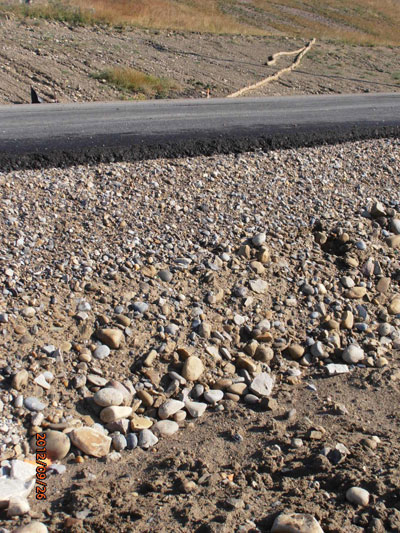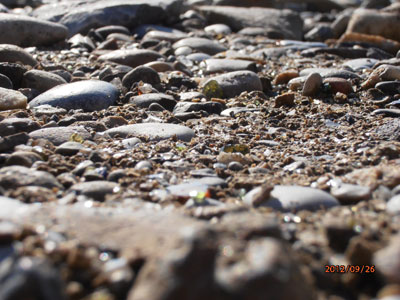
Features
Aggregates
Technology
Green Additive for Road Aggregate
City of Calgary experimenting with recycled glass in road aggregate.
December 3, 2012 By Peter Caulfield
The City of Calgary recently completed building an access road, on the
site of one of its landfills, that uses a very unusual material: finely
crushed glass from the city’s recycling depot.
The City of Calgary recently completed building an access road, on the site of one of its landfills, that uses a very unusual material: finely crushed glass from the city’s recycling depot.
 |
|
| The crushed glass, mixed with the aggregate, provides a good material for a sub-base and works as curb material on major thruways and highways.
|
The glass, which is mixed with aggregate, forms part of the sub-base of an approximately 1,080-metre access road that runs from 69th Street NW to the scale house at the Spyhill landfill in northwestern Calgary. Construction of the road was completed in September 2012.
City of Calgary waste diversion specialist Parnell Legg says the glass is collected from a number of different sources: The City’s residential Blue Cart recycling program, community recycling depots and commercial recycling operations.
Calgarians aren’t required to separate glass jars and bottles from their other recyclable materials, such as plastics, paper, cardboard and food cans; they’re allowed to throw everything into the same receptacle. After the City collects the material, it goes to a sorting facility in southeastern Calgary.
“The glass is sorted from the other material, crushed and then collected in the East Calgary landfill, which is one of three Calgary landfills,” Legg said.
To process the glass to the consistency at which it can be mixed with aggregate, Copper Stone Crushing, of Rocky View, Alta., crushed it into five-millimetre pieces. Pro-Con Road Works Ltd., also of Rocky View, is the contractor that built the road to the scale house.
It costs about $29 per tonne to clean and crush the glass, which is comparable to the cost of a tonne of aggregate in Calgary. As a result, the municipality hasn’t yet saved any money by using crushed glass as a partial substitute for aggregate.
“By using recycled glass, Calgary can hold onto its natural aggregate for future use,” Legg said. “At the same time, it can make good use of the glass it collects in its recycling program.”
 |
|
| The recycled glass is visible within the aggregate mix when it is applied on the roadway.
|
The City’s decision to use its stockpile of recycled glass to pave the access road to the landfill came after its first plan for dealing with it fell through.
“We had planned to sell the glass to a local company that was going to turn it into fibre glass and sell it to contractors in the residential construction industry,” Legg said.
But the subsequent cooling of the housing market put the kibosh on that idea. The City was able to come up with a Plan B, however. While it was searching for other uses for its by now small mountain of crushed glass, City officials discovered that it could be used as an aggregate material.
“Crushed glass is an almost ideal substitute for aggregate when mixed in the right proportions,” Legg said. “It is readily available, freely draining, environmentally clean and its performance properties equal or exceed those of most natural aggregates.”
In 2010, the City decided to use crushed glass as a partial replacement for aggregate on its Spyhill landfill scale house project. The project used a total of 32,000 tonnes of sub-base material, including aggregate, of which roughly 3,200 tonnes were glass. The crushed glass formed 10% of the sub-base of the road.
Legg said the City is planning to use the glass it continues to collect on a project similar to the one at the Spyhill landfill. As part of an upgrade of the East Calgary landfill slated for 2013, the glass will be blended into both the sub-base and the base of a new scale house access road.
The City hopes the demonstration projects will enable it to develop local markets for its recycled glass with private-sector contractors who can use it in some of their projects.
The City has been stockpiling crushed glass since 2009. It collects about 5,000 tonnes of glass per year, which is about 7% of all of its recycled materials. In 2011, Calgary collected, processed and shipped a total of more than 70,000 tonnes of recyclable material.
The technological benefits of using recycled glass as a construction aggregate are well established. According to the Clean Washington Center in the United States, more than 50,000 tons of the material have been used in construction projects in the state of Washington alone. In addition, says the centre, department of transportation specifications in at least six U.S. states have been amended to allow the use of recycled glass in road projects.
To promote the use of glass as an aggregate, Soil & Environmental Engineers, Inc. and Re-Sourcing Associates, Inc. have prepared for Clean Washington Center a paper entitled A Tool Kit for the Use of Post-Consumer Glass as a Construction Aggregate, which can be found at http://www.cwc.org/glass/gl975.htm .
According to the document’s authors, the tool kit is aimed at project owners, designers, contractors, material suppliers, and specifying and permitting agencies. Its purpose is to improve the quality of the information available on the use of glass as a construction aggregate, in order to increase the confidence with which glass can be used as a replacement for mineral aggregates, as well as in other uses. The tool kit combines technical information and examples of successful uses of glass in different construction applications.
Print this page